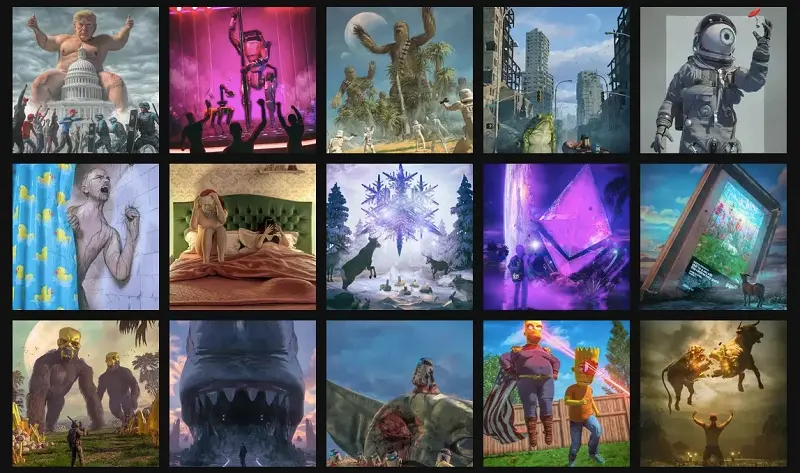NFT smart contracts explained
Due to its non-fungible nature, each NFT is unique and only one person can own it at a time, unlike cryptocurrency tokens with billions available. Because of this, NFT is often tied to a token ID or metadata, storing the proof of ownership.
This is when smart contracts come to the scene. This self-executing digital document controls and assigns ownership for the NFT, allowing you to create, trade, or destroy it (which we’ll cover later). In other words, the NFT can’t exist without smart contracts.
NFT and smart contracts are intertwined. And the birth of smart contracts has created a robust and growing market for NFT today.
Real-life examples of NFT smart contracts
We’ve learned that smart contracts power NFT; let’s see how those two work in real life:
On March 11, 2021, a digital artwork titled “The First 5000 Days” by Mike Winkelmann was sold for a record-high price of 69 million USD. Its reserve was only 100 USD. The auction takes place through an Ethereum Smart Contract. Ownership of this NFT lot will be “wired” directly to the bidder’s wallet. This is the first time Christie’s has auctioned a digital artwork and called it “an important milestone in the development of the market for digital art.”

Another NFT smart contract example is the NFT games, such as a trading card game. Each card is encoded as an NFT, and when players trade or fight cards with each other, smart contracts will automatically switch ownership. You can also reward players who complete a certain task. All of this can be done in the blink of an eye with NFT smart contracts.
Core function of smart contracts and NFT
What they can do with each other:
Mining, Transferring and Trading NFT
Minting is the process of converting a regular digital asset into a digital asset stored on the Blockchain. This process officially makes those digital assets NFTs, and you can trade them on an NFT marketplace.
During this, smart contracts will identify the NFT’s use, properties, and ownership, allowing it to be created and published. Once the data is verified, the owner can freely trade, sell, and monetize the NFTs. The owner’s wallet address will be automatically updated when an action, such as transferring or trading, is completed.
Burn and destruction
What can be created can also be destroyed. Burning an NFT will completely remove it from the blockchain and reduce the total supply. In most cases, people do it because the NFT is no longer relevant; they want to redeem physical items, create scarcity or simply free up their storage from unwanted tokens. This action is irreversible.
Preventing plagiarism and spoofing through Metadata
Copywriting remains an intractable problem in the digital world. How do you prove something is original when copying and pasting is done with one click? Many valuable works of digital art have been stolen and copied.
NFT and smart contracts have it covered. Each NFT is a unique digital token saved in public smart contracts that proves its authenticity and ownership to everybody. Through the token ID and wallet address on the smart contract, we can know exactly who owns NFT and its transaction history.
This is also known as the metadata. You can store the metadata on-chain (on the blockchain and smart contracts) and off-chain (in other databases). Remember that keeping it on-chain will allow everyone to search and access it.
Royalties and secondary sales
Certain NFT smart contracts incorporate royalty mechanisms. That is, in addition to earning from the first sale, creators can make the cut from royalties for each secondary sale. A few lines of code in smart contracts can simplify all that.
For buyers, this is a nice opportunity to collect unique and limited collectables. While purchasing music on a traditional website, you only purchase the “right” to enjoy the music but do not own the “copywrite”, which allows you to commercialize it. On the NFT marketplace, you have full rights to use or even resell them.
Integration with DeFi platforms
One NFT adheres to multiple protocols, such as ERC 721 or ERC1155, allowing compatibility with different markets and platforms.
NFTs can be a powerful tool as they can be used as collaterals to make a profit or even as a part of more complex financial instruments on decentralized finance exchanges. This integration can be built directly into the NFT smart contract and is expected to become a breakthrough in the blockchain world.
Asset control & permission
NFT smart contracts can be used to control access to specific assets, that is, only authorized addresses can mint, burn, or perform other administrative functions. This is to maintain the security and integrity of the NFT system.
How to read NFT smart contracts
As a smart contract contains all the information about an NFT project, such as ownership, transaction, and project popularity, you can investigate down to the smallest details before taking action. This protects transparency and the buyer’s benefit.
Step 1: Fetch a NFT smart contract address
You can search for the contract addresses on Binance NFT, other NFT platforms, and the ERC-721/BEP-721 token section on the Etherscan/BSCscan page in your wallet or OpenSea.
In this article, we will guide you on How to get NFT smart contracts on Opensea.io – the largest web3 marketplace for NFTs and crypto collectables.
- Visit opensea.io to search for NFT projects by entering keywords in the search bar or click on the Stats tab to view NFT projects in ranking order. This section allows you to filter projects by time/volume/ % change/ floor price and sales. Click on any NFT project you are interested in to view details.
- Click to select any item listed in the project. Scroll down to the Details section for: Contract Address, Token ID, Token Standard, Chain, Last Updated and Creator Earnings
- Copy the contract address or click directly on that address. Now you have the address.

Step 2: Read a NFT contract with Etherscan.io
Since most NFTs are built on Ethereum, we will take the Ethereum NFT smart contract as a case study.
All the Ethereum NFT smart contract data is available on the Etherscan.io
Heading to the Etherscan homepage, the first thing you probably noticed is the search bar where you can look up specific wallets, smart contract addresses, Txn hash and specific tokens.
Here we’re going to enter a contract address earlier on Opensea and see if they have been verified and explore the information.

First and foremost, you will see some overview about the ETH balance, ETH value and token holdings
Contract creator
This includes contract deployer and transaction hash.
If you click contract deployer, it’s going to show you the Wallet address of this creator with some basic info like Wallet balance/ value/ Token holdings. Scroll down a bit and you can view transactions history from this wallet address.
If you click Txn hash, it shows you details about the initial contract deployment including Transaction confirmation; timestamp, quantity minted of token, contract creator, fee paid.
Token Tracker
Token Tracker gives you some insight into:
- Minimum token values
- Overview: Max total supply; Total holders; Total transfer
- Market: Volume, Min price, Max price (within 24h)
- Holder tab: Display ranking of token holders (by quantity and percentage) in the contract
Transaction tab
Now let’s dive into the Transaction tab of a NFT smart contract.
The first column – Transaction hash is a chronological list of all transactions. They can be clicked into to see more details (status, block, timestamp, gas price, seller/ buyer wallet address, value, transaction fee)
Next column is “Method”, they are function executed in smart contract. Every contract in different but common method including my mint, transfer and approval setting
Contract tab
Contract tab includes 3 subtabs
- Code: Displays the source code of the contract and code verification status (Keep in mind that source code verification does not imply that the contract is 100% safe to interact with)
- Read contract.
- Write contract: It is where you can connect your wallet with web3. This tab allows the owner to initiate functions (if your wallet is qualified) such as granting roles, pausing, burning tokens, approving transactions, transferring tokens, and more.
Analytic
Finally let’s check the Analytic tab
Analytic tab represents Ether balance/ Transaction/ Txn fees/ Ether transfer/ Token transfer/ Txn heatmap transactions in a chart. It’s going to give you an intuitive overview of the general trend of projects you are interested in.
Etherscan.io also provides many other features which are not mentioned here. However, the above features are the basics that you need to know about an NFT smart contract.
How to create NFT smart contracts
Most current NFT smart contracts are based on two popular standards of Ethereum, ERC721 and ERC1155.
ERC721 (Ethereum Request for Comment 721) is the first protocol for NFT on Ethereum. This standard requires tokens to be unique and non-fungible, which other standards do not require.
ERC-1155 (Ethereum Request for Comments 1155) is a mixture of ERC-20 and ERC-721. It creates both fungible and non-fungible tokens in a single smart contract. This standard offers a lot of outstanding advantages compared to its predecessors, especially its versatility and gas-saving (it claims to cut gas fees by up to 90% when minting new tokens). It is used mainly in NFT games.
Sum up of the steps to write a good NFT smart contracts:
- Pick your NFT type: ERC721 or ERC1155.
- Choose a chain to deploy your smart contracts.
- Choose metadata storage: on-chain or off-chain.
- Pick your tech stack and code the smart contracts.
- Check your security essentials including tools and audit methodology.
- Testing and optimizing your gas usage if needed.
- Deploy it, make sure the minting and admin function is in place.
For more details on how each step works (with tips and tools to use), read these 73 steps NFT smart contract tutorial from QuickNode!
Also, if your contract is simple and you want something to quickly generate it, here’s a list of template and NFT smart contract generator from Alchemy!
Choosing a NFT smart contracts developers
Once being deployed, NFT smart contracts can’t be changed. Any faults and errors are the open door for exploitation. The best way is to prevent it firsthand and having an expert team in blockchain, smart contract and legal by your side is the first step!
This is why businesses have entrusted Synodus with building smart contracts and NFT marketplace!
Our team of blockchain and legal experts are ready to take on your challenge, not just as a technical partner, but also a consultant on your business growth and how to monetize the blockchain world!
250+ well-verse developers, constructed solution and optimized pricing plan are all you need!
A few tips to evaluate NFT smart contracts developers:
Portfolio
This is the clearest proof of the capacity and qualifications of the company experts – the people behind the company’s NFT projects. You should check for their blockchain focus (as the technology is vast) and their past exposure with smart contracts.
Reviews
Check for credentials to see what their past clients said about their work. You can see reviews on Google, social media, and listing sites such as Clutch or Goodfirms. However, you should read these reviews with caution because they may come from their own communications department or from their competitors.
Budget
Budget is also a factor to consider when choosing a development company for NFT smart contract projects.
Your first order of business is to set out your own budget. You should consult at least two companies for a comparison of the pros and cons that each company offers in that price bracket. Keeping a good grip on market prices and knowing exactly what you need will give you a great advantage in negotiating with the company.
A good deal is a deal that bangs for your buck, not a low or high price deal.
Customer service
During the process or even after getting your work done, you will need support from the company. Choose a company with 24/7 customer service so you will get their support anytime.
Upcoming trends and insights for NFT smart contracts
NFT cropped up in 2014 and has exploded on the market in recent years, yet its huge potential has not been fully exploited. Let’s see what the future holds for NFT and NFT smart contracts in the next few years.
Interoperability
Although most NFT projects are currently built on the ERC standard, there are a flood of other standards in the blockchain ecosystem, which also helps pave the way for NFT smart contract development in the future: beefing up compatibility with many other standards, improving cross-interoperability, and transferring assets on different blockchain platforms.
Sustainable technology
The rapid development of blockchain is making a significant impact on the environment. This is an alerting issue but has not really received enough attention.
Blockchain technologies, especially NFTs smart contracts using Proof-of-work mechanisms, consume a large amount of energy and emit a lot of CO2s during operation. Therefore, technologies that are environmentally friendly alternatives and consume less energy are the future of not only blockchain but also other industries.
Upgradable smart contracts
Immutability is the key factor that guarantees security for the blockchain but stands as a challenge at the same time. As blockchain technology develops to the next level, a smart contract that allows updates and compatibility while still ensuring the integrity and decentralization of the blockchain is possible.
FAQ
NFT can’t run without smart contracts. Since smart contracts contain information about the ownership of the NFT that allows you to trade, sell and monetize them, it won’t exist without smart contracts.
An NFT smart contract costs around $500 to $3000 based on complexity. The basic formula to calculate how to deploy and manage them are: Deployment cost = Units of gas *price of gas * value of ETH.
No, NFT is minted through smart contracts. Smart contracts also help operate NFT.
Wrapping up
Hopefully this article will give you an overview of NFT smart contracts, how they work, their applications and expected growth in the future. Follow us to not miss any future blockchain trends. If you have any further questions, don’t hesitate to reach out to us.
How useful was this post?
Click on a star to rate it!
Average rating / 5. Vote count:
No votes so far! Be the first to rate this post.




